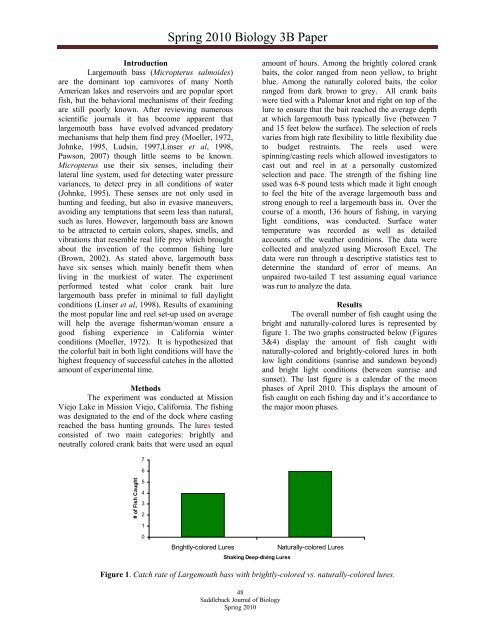Saddleback Journal of Biology - Saddleback College
Saddleback Journal of Biology - Saddleback College
Saddleback Journal of Biology - Saddleback College
Create successful ePaper yourself
Turn your PDF publications into a flip-book with our unique Google optimized e-Paper software.
Spring 2010 <strong>Biology</strong> 3B Paper<br />
Introduction<br />
Largemouth bass (Micropterus salmoides)<br />
are the dominant top carnivores <strong>of</strong> many North<br />
American lakes and reservoirs and are popular sport<br />
fish, but the behavioral mechanisms <strong>of</strong> their feeding<br />
are still poorly known. After reviewing numerous<br />
scientific journals it has become apparent that<br />
largemouth bass have evolved advanced predatory<br />
mechanisms that help them find prey (Moeller, 1972,<br />
Johnke, 1995, Ludsin, 1997,Linser et al, 1998,<br />
Pawson, 2007) though little seems to be known.<br />
Micropterus use their six senses, including their<br />
lateral line system, used for detecting water pressure<br />
variances, to detect prey in all conditions <strong>of</strong> water<br />
(Johnke, 1995). These senses are not only used in<br />
hunting and feeding, but also in evasive maneuvers,<br />
avoiding any temptations that seem less than natural,<br />
such as lures. However, largemouth bass are known<br />
to be attracted to certain colors, shapes, smells, and<br />
vibrations that resemble real life prey which brought<br />
about the invention <strong>of</strong> the common fishing lure<br />
(Brown, 2002). As stated above, largemouth bass<br />
have six senses which mainly benefit them when<br />
living in the murkiest <strong>of</strong> water. The experiment<br />
performed tested what color crank bait lure<br />
largemouth bass prefer in minimal to full daylight<br />
conditions (Linser et al, 1998). Results <strong>of</strong> examining<br />
the most popular line and reel set-up used on average<br />
will help the average fisherman/woman ensure a<br />
good fishing experience in California winter<br />
conditions (Moeller, 1972). It is hypothesized that<br />
the colorful bait in both light conditions will have the<br />
highest frequency <strong>of</strong> successful catches in the allotted<br />
amount <strong>of</strong> experimental time.<br />
Methods<br />
The experiment was conducted at Mission<br />
Viejo Lake in Mission Viejo, California. The fishing<br />
was designated to the end <strong>of</strong> the dock where casting<br />
reached the bass hunting grounds. The lures tested<br />
consisted <strong>of</strong> two main categories: brightly and<br />
neutrally colored crank baits that were used an equal<br />
amount <strong>of</strong> hours. Among the brightly colored crank<br />
baits, the color ranged from neon yellow, to bright<br />
blue. Among the naturally colored baits, the color<br />
ranged from dark brown to grey. All crank baits<br />
were tied with a Palomar knot and right on top <strong>of</strong> the<br />
lure to ensure that the bait reached the average depth<br />
at which largemouth bass typically live (between 7<br />
and 15 feet below the surface). The selection <strong>of</strong> reels<br />
varies from high rate flexibility to little flexibility due<br />
to budget restraints. The reels used were<br />
spinning/casting reels which allowed investigators to<br />
cast out and reel in at a personally customized<br />
selection and pace. The strength <strong>of</strong> the fishing line<br />
used was 6-8 pound tests which made it light enough<br />
to feel the bite <strong>of</strong> the average largemouth bass and<br />
strong enough to reel a largemouth bass in. Over the<br />
course <strong>of</strong> a month, 136 hours <strong>of</strong> fishing, in varying<br />
light conditions, was conducted. Surface water<br />
temperature was recorded as well as detailed<br />
accounts <strong>of</strong> the weather conditions. The data were<br />
collected and analyzed using Micros<strong>of</strong>t Excel. The<br />
data were run through a descriptive statistics test to<br />
determine the standard <strong>of</strong> error <strong>of</strong> means. An<br />
unpaired two-tailed T test assuming equal variance<br />
was run to analyze the data.<br />
Results<br />
The overall number <strong>of</strong> fish caught using the<br />
bright and naturally-colored lures is represented by<br />
figure 1. The two graphs constructed below (Figures<br />
3&4) display the amount <strong>of</strong> fish caught with<br />
naturally-colored and brightly-colored lures in both<br />
low light conditions (sunrise and sundown beyond)<br />
and bright light conditions (between sunrise and<br />
sunset). The last figure is a calendar <strong>of</strong> the moon<br />
phases <strong>of</strong> April 2010. This displays the amount <strong>of</strong><br />
fish caught on each fishing day and it’s accordance to<br />
the major moon phases.<br />
7<br />
6<br />
# <strong>of</strong> Fish Caught<br />
5<br />
4<br />
3<br />
2<br />
1<br />
0<br />
Brightly-colored Lures<br />
Shaking Deep-diving Lures<br />
Naturally-colored Lures<br />
Figure 1. Catch rate <strong>of</strong> Largemouth bass with brightly-colored vs. naturally-colored lures.<br />
48<br />
<strong>Saddleback</strong> <strong>Journal</strong> <strong>of</strong> <strong>Biology</strong><br />
Spring 2010

















